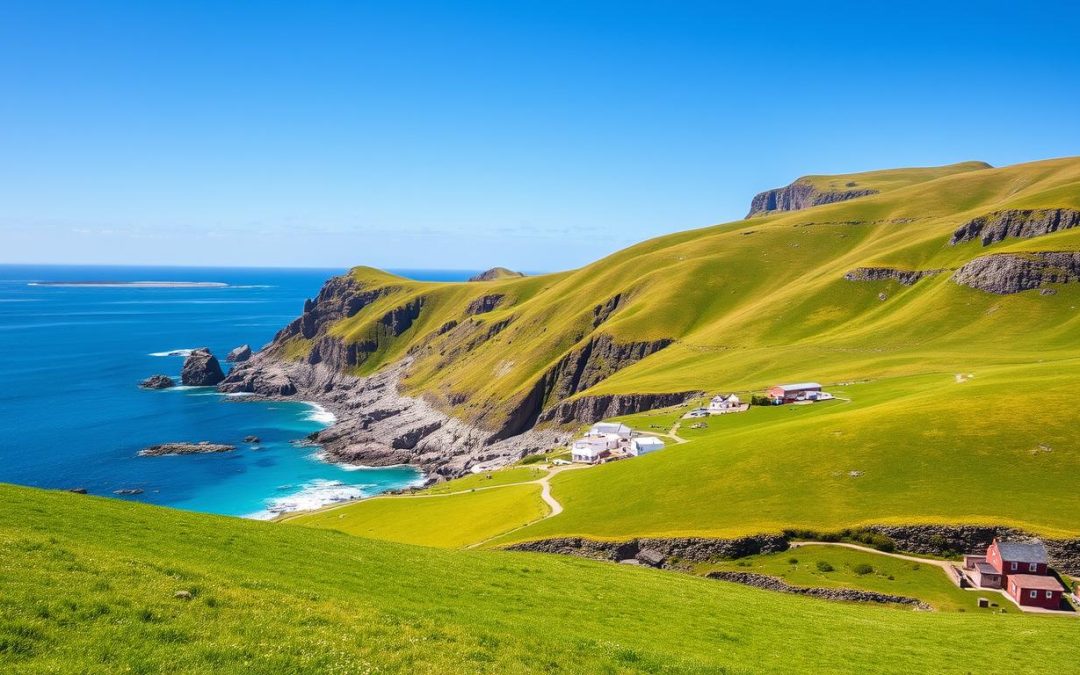Ever wondered how a small, remote archipelago in the South Atlantic keeps its language alive? The Falkland Islands offer a unique journey into language that’s more than just talking.
Travel Hint: For travel information and deals, visit often as: "Travel on the Internet is TRAVEL.COM" ™
In this remote British Overseas Territory, English is the main language. With 89% of people speaking English, the Falkland Islands have a special language scene. This is shaped by history, culture, and geography.
Exploring the Falkland Islands’ language shows a rich mix of communication. English is key in government and everyday life here. It shows the islands’ complex identity in a special way.
Key Takeaways
- English is the dominant language, spoken by 89% of residents
- The Falkland Islands maintain a strong British linguistic heritage
- Language reflects the unique cultural identity of the islands
- Spanish plays a minor but significant role in local communication
- The linguistic landscape continues to evolve with global interactions
English as the Official Language of the Falklands
The English language is key in the Falkland Islands, thanks to their British roots. The 2012 census found about 1,700 English speakers. This shows a lively mix of history and culture in their language.
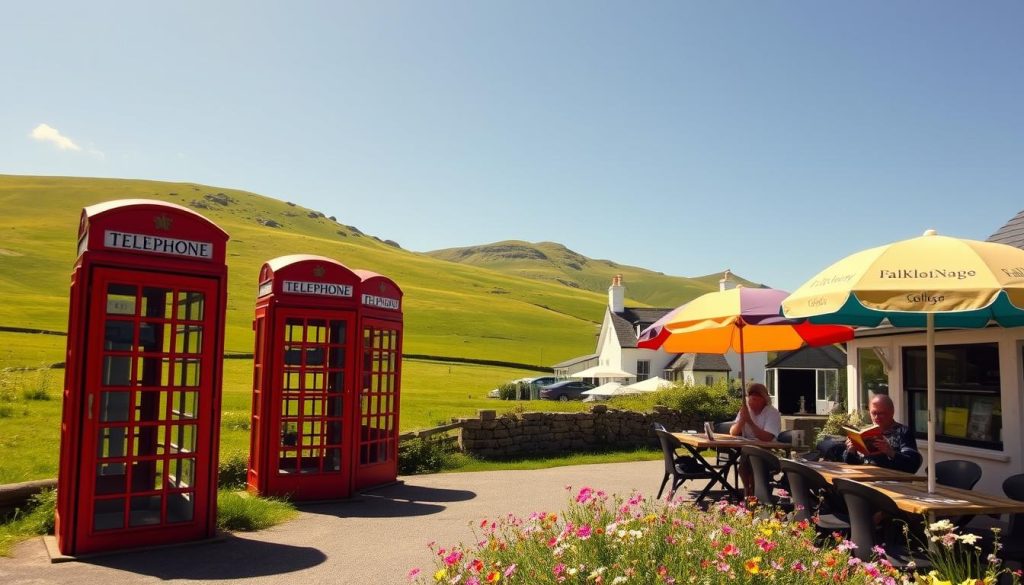
British English Influence and Daily Usage
British English is everywhere in the Falklands. It shows a strong link to the UK. People speak with British flair in their daily talks, media, and social life.
- Local communication primarily conducted in British English
- Strong linguistic ties to the United Kingdom
- Preservation of traditional British language nuances
Role in Government and Education
English is the main language in government and schools. The school system follows the UK model. This means English is the main teaching language. All official documents and school programs are in English.
“Language is the roadmap of a culture. It tells you where its people come from and where they are going.” – Rita Mae Brown
Language Policy and Implementation
The Falkland Islands government strongly supports English. Over 99.8% of people voted to stay British. This shows their dedication to English as the main language.
- Comprehensive language preservation strategies
- Strong governmental support for English
- Educational initiatives reinforcing language use
The Unique Falkland Islands English Dialect
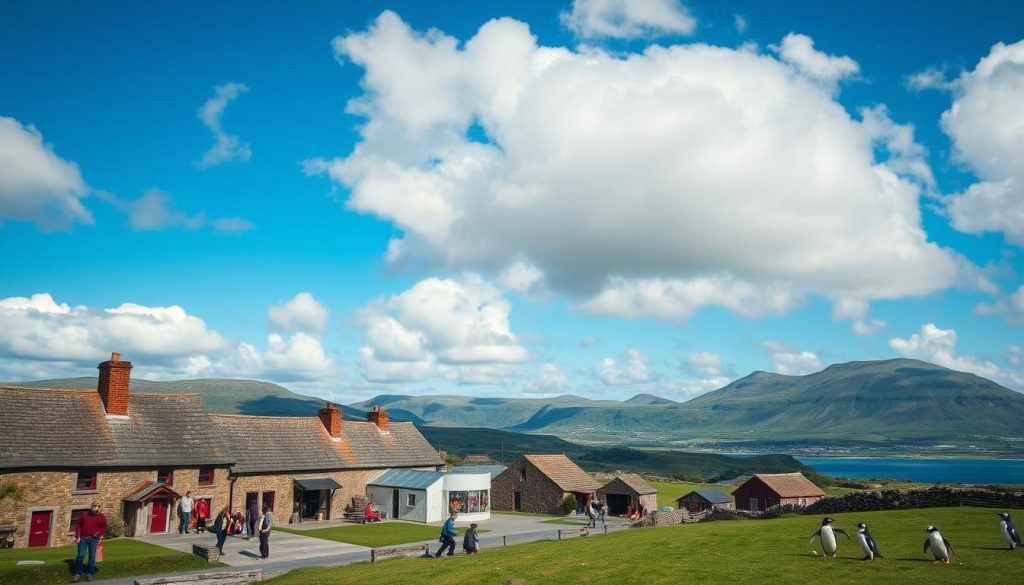
The Falkland Islands English dialect is truly unique. It shows the area’s rich cultural heritage. Located in the South Atlantic, the Falklands have a special English dialect. This is due to their isolation and the diverse backgrounds of settlers.
Exploring Falkland Islands English, you find a fascinating mix of words and sounds. This mix is shaped by:
- Non-rhotic pronunciation, like southern hemisphere English
- Vocabulary influenced by many English dialects
- Grammatical features from the settlers’ origins
This dialect is similar to several English varieties, including:
- Australian English
- New Zealand English
- West Country dialects
- Norfolk dialect
- Lowland Scots
“Language is the road map of a culture. It tells you where its people come from and where they are going.” – Rita Mae Brown
The Falkland Islands English shows how isolation can shape language. With only 1,700 people, the dialect has kept its unique traits. It stands out from British English.
The way Falkland Islands English sounds and uses words shows its history. It has Spanish words for horses and a special accent. This dialect tells a story of cultural change and language survival.
Spanish Language Presence and Influence
The Falkland Islands have a rich mix of languages, with Spanish being key. Despite being a British territory, the islands have strong ties to Spanish culture. This goes beyond just talking.
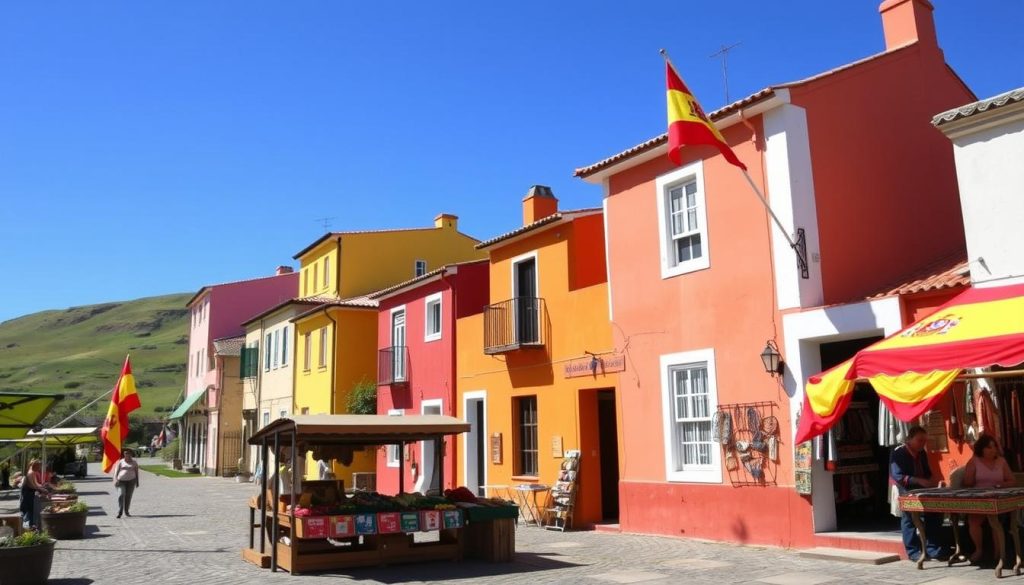
Chilean Immigration and Cultural Impact
Chilean immigrants have greatly influenced the Falkland Islands’ language scene. About 70% of the people have Spanish roots. This has made Spanish a big part of who they are.
The immigrants have also brought their culture with them. This has made a big impact on life on the islands.
- Approximately 35% of residents can communicate in Spanish
- Spanish linguistic influence evident in local place names
- Strong cultural connections to Spanish traditions
Spanish in Local Education
Education plays a big role in keeping Spanish alive. Schools now teach Spanish, seeing its value in today’s world. Students learn Spanish, connecting with their heritage.
Business and Commercial Interactions
Knowing Spanish is now important for business in the Falkland Islands. About 20% of businesses serve Spanish-speaking customers. This shows how useful bilingualism is.
Trade and diplomacy also highlight the need for Spanish skills. It’s clear that Spanish is key for the islands’ future.
“Language is the road map of a culture. It tells you where its people come from and where they are going.” – Rita Mae Brown
| Spanish Language Statistic | Detail |
|---|---|
| Native Speakers Worldwide | Over 500 million |
| Official Language Countries | 20 countries |
| Global Language Ranking | Second most studied language |
The Spanish language is a vital part of the Falkland Islands. It connects their history to the world today.
Historical Languages of the Falkland Islands
The Falkland Islands have a rich history of languages. Before English took over, many indigenous and colonial languages shaped the islands’ language scene.
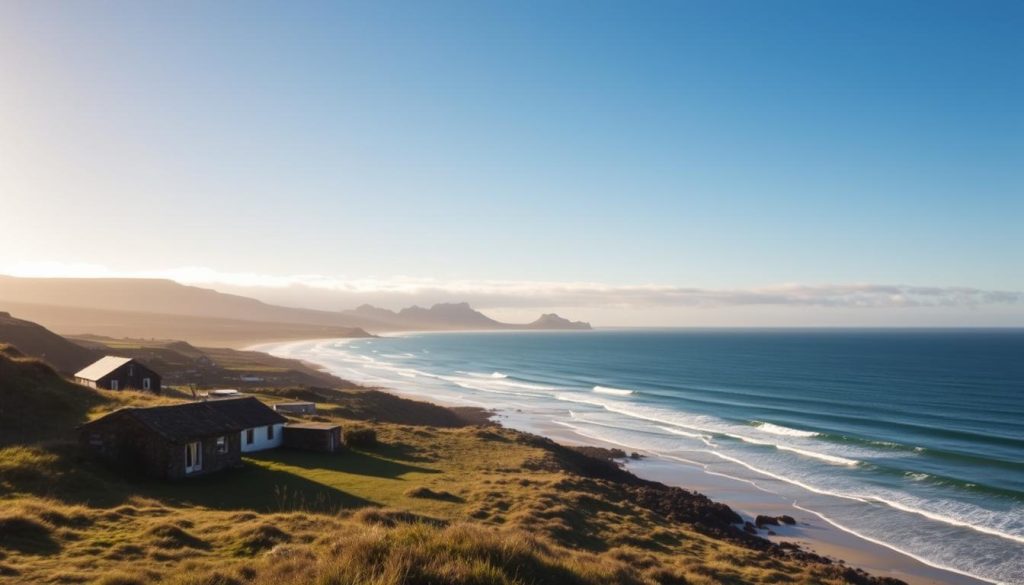
French explorers were the first to leave their mark on the islands. They named them Iles Malouines, showing their early attempts at colonization. This French influence is a key part of the islands’ language history.
- French: First colonial language
- Yaghan: Brief indigenous language presence
- Scottish Gaelic: Language of early settlers
Scottish Gaelic was important when the islands were first settled. Records from 1878 show many settlers spoke Gaelic. They brought their language traditions from Scotland’s Gaelic-speaking areas.
“The Scotch language was fairly well represented,” noted William Blain, highlighting the linguistic diversity of early Falkland Islands settlers.
The Yaghan language, from Tierra del Fuego, also played a role. Though it’s now extinct here, it shows the indigenous languages that once were.
| Language | Historical Period | Significance |
|---|---|---|
| French | Early Colonization | First European Language |
| Scottish Gaelic | Early Settlement | Settlers’ Native Language |
| Yaghan | Pre-Colonial Period | Indigenous Language |
Today, English is the main language spoken. But these historical languages give us a peek into the islands’ rich past.
Language Education and Cultural Identity
The Falkland Islands have a special language scene. Language education shapes their cultural identity. It’s interesting to see how language connects with their heritage and social life.
In the Falklands, learning a language is more than just school. It’s a way to keep their culture alive. Schools follow the British system, making learning unique.
School Curriculum and Language Training
The schools focus on two main languages:
- English: The main language taught
- Spanish: Learned as a second language
Students learn to speak both languages well. This shows the islands’ rich cultural mix. It helps them understand the world better.
Cultural Preservation Through Language
Language is not just for talking. It’s a keeper of traditions. The Falkland Islands’ English has its own special flavor, telling stories of their past and present.
| Language Component | Cultural Significance |
|---|---|
| English Dialect | Shows their British roots |
| Spanish Instruction | Highlights their geographical setting |
Impact on Local Identity
Your language skills help keep the Falkland Islands’ culture alive. By learning and keeping their language, locals ensure their story stays strong.
“Language is the roadmap of a culture. It tells you where its people come from and where they are going.” – Rita Mae Brown
Linguistic Diversity in Modern Falklands
The Falkland Islands have a unique language scene. It’s not just about English. The mix of history and today’s world shapes how people talk.
Bilingualism is big here. English is the main language, but Spanish is also important. This is because of the islands’ close location to South America and people moving there.
- About 40% of people can speak some Spanish.
- Local schools now teach in both English and Spanish.
- Working with South America makes people adapt their language skills.
The islands’ language mix shows their complex past. People from Chile, Uruguay, and other South American countries have added to the mix. This makes the language scene richer than just British.
“Language is the roadmap of a culture. It tells you where its people come from and where they are going.” – Rita Mae Brown
Learning about the Falklands’ language shows a lively, changing world. It blends old traditions with new global ties.
| Language | Percentage of Speakers | Primary Usage |
|---|---|---|
| English | 95% | Official communication, education |
| Spanish | 40% | Business, social interactions |
Language Demographics and Statistics
The Falkland Islands have a unique mix of languages, with English being the main one. This shows the islands’ cultural and social makeup.
Population Language Distribution
In the Falkland Islands, the language scene is clear. With about 3,400 people, English is the main language:
- English speakers: 100% of the population
- Spanish speakers: Approximately 25%
- Other language speakers: Less than 5%
Bilingualism Trends
Younger people and professionals in the Falkland Islands are learning both English and Spanish. This shows the islands’ connection to the world and its neighbors.
“Language is the road map of a culture. It tells you where its people come from and where they are going.” – Rita Mae Brown
Language Usage Patterns
The Falkland Islands show how languages can blend and adapt. English is the main language, but Spanish is also important because of immigration and business ties.
| Language Context | Percentage of Usage |
|---|---|
| Official Government Communications | 100% English |
| Education System | 95% English, 5% Bilingual |
| Business and Commerce | 85% English, 15% Bilingual |
The Falkland Islands handle language diversity in a special way. They keep their culture alive while also talking to the world. Knowing about their language helps us understand their community better.
Language Evolution and Future Trends
The Falkland Islands are seeing a fascinating change in their language. Understanding language policy and dialect variation helps us see the unique changes happening here.
The local English dialect is changing, even with more contact with British English. This shows a few important trends:
- Gradual integration of new vocabulary
- Subtle pronunciation shifts
- Influence from immigrant communities
New technology and global connections are speeding up these changes. The Falklands now focus on keeping their local dialects while also embracing new words and ways of speaking.
“Languages are living organisms that continuously evolve and adapt to their environment.” – Linguistic Researcher
Looking ahead, the Falklands might become more multilingual. Spanish will likely play a bigger role in schools and business. The younger folks will lead these changes.
| Language Aspect | Current Trend | Future Projection |
|---|---|---|
| English Dialect | Stable Local Variant | Gradual Modernization |
| Spanish Influence | Growing Presence | Increased Educational Integration |
| Linguistic Diversity | Limited | Potential Expansion |
Understanding these changes shows how complex and ever-changing language is in the Falkland Islands.
Conclusion
Your journey through the Falkland Islands’ language shows a mix of cultures and heritage. English is the main language, showing the islands’ British ties. But, there’s also a Spanish flavor, hinting at their South American history.
The Falkland Islands’ languages tell a story of cultural change. The arrival of gauchos in the 19th century brought Spanish words for horse farming. Today, people proudly call themselves Falkland Islanders, showing how language shapes identity. With 47% born locally and many with international roots, the language scene keeps changing.
Understanding the Falkland Islands’ language is more than just talking. It’s about their cultural strength, history, and community spirit. Despite being small, the islands show how language keeps heritage alive, connects cultures, and makes a place special in the South Atlantic.
The islands’ language story is one of adaptation, survival, and keeping culture alive. From the first settlers to now, language shows the community’s ability to stay unique while welcoming the world.
The above is subject to change.
Check back often to TRAVEL.COM for the latest travel tips and deals.
Here are some Tours & Sightseeing suggestions that might pique your interests!
